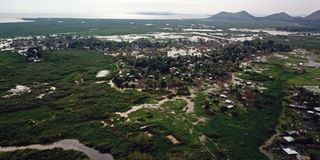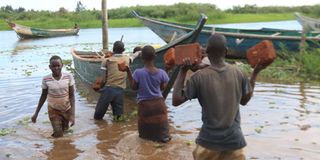Flood of broken promises a pain to languishing Budalang’i residents

Flooded homes in Mau Mau, Budalang’i, Busia County. Many families in affected areas are currently camping in schools.
What you need to know:
- The few schools located in upper grounds around Port Victoria town have been playing host to hundreds of households forced out of their homes by the floods.
- The ministry says less than a third of the World Bank funded project has been implemented and residents will have to wait until December 2022.
- The irrigation project alone requires 583 parcels of land just for the first 20km of the main irrigation canal.
In parts of Budalang’i, murram roads complete with bridges and power lines on the sides have turned into waterways. Boats have displaced cars and motorcycles as the means of transport between villages.
Several schools are still completely submerged, pupils as young as 10, who are also on the long Covid-19 break, have become the new coxswains, rowing boats along the roads and ferrying residents between flooded sections at Sh20 per trip.
The few schools located in upper grounds around Port Victoria town have been playing host to hundreds of households forced out of their homes by the floods after dykes around River Nzoia broke and directed the water flow to the villages.
Osborne Opondo, a father of nine is one of the 894 families the government says were displaced. We met him at Bubango Primary School where four families are forced to share one classroom with scarce water and food supply.
“I have been here since May 2020, others have been out of their homes since September 2019. As you can see Covid-19 is not our disaster, we have more challenges than worrying about social distancing and wearing of masks when we have to put up in this kind of situation,” he said as he went on with repair works on old furniture belonging to the displaced families in preparation to exit the institution as schools reopen from tomorrow.
Little privacy
There is little privacy in the classrooms where parents had to agree on reorganising children accommodation for older girls and boys to be separated in different streams to avert an emerging crisis of teenage pregnancies. This meant more couples in the classroom and a less dignified life.
The dire situation was triggered by the triple occurrences of dykes breaking, the river flooding and the Lake Victoria levels rising, flowing back and making matters worse for villages who were caught unaware (some for the first time ever) and had to move out of their homes for as long as over one year.

Budalang’i residents in Busia County use a boat to transport bricks across their flooded village.
It is seven years since the World Bank gave the Kenyan government some Sh23.4 billion to address the perennial flooding that keeps pushing this part of Busia County further into poverty. It has only gotten worse as blame games between local leaders, the residents and the Ministry of Water, Sanitation and Irrigation continue.
The ministry says less than a third of the World Bank funded project has been implemented and residents will have to wait until December 2022.
CS Sicily Kariuki, in a statement to Sunday Nation, said the Lower Nzoia Irrigation Project, which involves the building of dykes around the River Nzoia and irrigation schemes to utilise the excess water, has been slowed by land acquisition.
Land acquisition
“The main reason for the delays is the slow pace of land acquisition. The project has approached the people whose land cannot be easily acquired due to these challenges so that the dykes can be constructed and hence protect them sooner in the event of flooding. They have fervently refused to allow the use of their land before receiving compensation,” the CS said, adding that it is also a World Bank policy that persons affected by projects must be compensated before taking their land for projects.
The Chinese contractor, Sino Hydro Corporation, which has been on site since then, is likely to demand more money as the project covering the repair and improvement of existing dykes as well as 34 kilometres stretch of new dykes along the river, runs into further delays.
The irrigation project alone requires 583 parcels of land just for the first 20km of the main irrigation canal. The government has managed to secure 315 parcels for a section of the dykes covering a third of the total length.

A man erects a tent near a dyke as a woman prepares a meal in Busagwa in Busia County on May 3, 2020.
The Lower Nzoia Irrigation Project was at the centre of a fall out within government last year after Deputy President William Ruto launched it in June at a pompous event only for the Ministry of Water to disown the launch as untimely. Some leaders feel such stand-off may have had a hand in the further delays of the project meant to be an economic stimulus for the county classified among the poorest in Kenya.
Local leaders including the area MP Raphael Wanjala sounded helpless in the midst of the crisis where locals are suffering, delays are stretching and emergency reposes like the repair of the broken dykes directing water from the river into villages could not happen immediately due to procurement bureaucracies.
Temporary accommodation
“We have appealed to the Red Cross since they were here on Friday to help us with tents for temporary accommodation of people who are now being forced to leave schools and settle in churches and other rescue centres. The solution to this problem will, however, have to involve the removal of the excess silt on the mouths of both River Nzoia and Yala as well as construction of dams upstream,” Mr Wanjala said.
The government, which on Tuesday, gave yet another warning for residents to move to higher grounds before the short rain season kicked in, claimed the construction of upstream dams in Bungoma and Kakamega areas has run into similar resistance by the residents who have refused to surrender land.
Hundreds of those in schools where the local administrators insist they must vacate by today remained pessimistic about any solution coming soon as emergency work to repair the dykes is yet to start.
“Maybe it will take another disaster like the drowning incident in 2014 that saw the government build the Sigiri Bridge. We cannot do business and we can hardly fend for our families in this situation. The government stopped supplying any food or clean water after evacuating us into these camps. We are just being asked to leave with no support or assurance of what follows after we leave,” said Mr Aburu Buluma, a local welder whose Mau Mau town business is still submerged in water.
Irrigation projects
Some locals claim the compensation offers are a mockery as several brokers promising to sort out land registration hurdles are milking those being awarded. The dykes and irrigation projects are also said to have become a conduit for graft for certain individuals keen to deliver a shoddy job and continue the cycle of the costly repairs.
In the upper parts of River Nzoia, the contractor is said to have been forced to start building dykes in areas with no threats of flooding as the local cartel wanted compensation directed to certain individuals first.
The government built the dykes almost 50 years ago and the seepage under them has weakened sections that now give in when water levels rise. The extraordinary rainfall that started in April 2019 has seen Lake Victoria level rise above the 1964 levels, going above its usual 12 metres levels to 13.4 metres and giving Bunyala a new taste of a disaster they were getting used to.
“We panic like monkeys do when they see signs of more rain, we pray for drought now. We have not had such a flood in many years, some people say since 1961 and every time it happens, we are pushed to almost a new beginning,” Mr Opondo told us as we left for another boat ride on the road.





